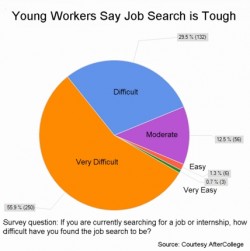At least no one is saying “Prosperity is just around the corner.” After Friday’s dismal jobs report, anyone even hinting that might be so would be subject to the same scorn that was heaped upon Herbert Hoover, the president of “rugged individualism,” who probably never actually uttered that phrase, though he came mightily close.
Yet despite the disheartening jobs report, news from the field, from the people in the best position to know of hiring plans, continues to point toward recovery.
 Monday, The Conference Board released its Employment Trends Index for May, which rose for the ninth month in a row. The Index stands at 95.7, up from April’s 95.2 and up nine percent over the last 12 months.
Monday, The Conference Board released its Employment Trends Index for May, which rose for the ninth month in a row. The Index stands at 95.7, up from April’s 95.2 and up nine percent over the last 12 months.
“The ongoing growth in the Employment Trends Index suggests that the disappointing uptick in payroll employment in May could just be a one-month blip, and that jobs will likely expand further in the next several months,” said Gad Levanon, associate director, Macroeconomic Research at The Conference Board. “However, as some of the components of the ETI have yet to signal robust gains, the pace of recovery in employment may remain moderate.”
 Today, Manpower released the results of its quarterly hiring survey, which says 18 percent of the 18,000 employers polled plan on hiring in the third quarter of the year. It’s the third consecutive quarter of a positive hiring outlook.
Today, Manpower released the results of its quarterly hiring survey, which says 18 percent of the 18,000 employers polled plan on hiring in the third quarter of the year. It’s the third consecutive quarter of a positive hiring outlook.
Manpower crunches the results to come up with a Net Employment Outlook. For the upcoming quarter that seasonally adjusted outlook is +6 percent. (From the percent of employers saying they plan to hire more, Manpower subtracts the percent who expect a payroll decrease — 8 percent in the current report. The result is adjusted to smooth seasonal fluctuations.)
“Manpower’s survey results show a positive trend in employers’ hiring plans,” said Jonas Prising, Manpower president of the Americas. “Although we are still facing a difficult labor market, more employers indicate confidence about the direction of their businesses, and with that comes an intention to increase their workforces. We are in the early stages of the jobs recovery, and although we have a long way to go, the job market will continue to improve from here.”
If you’ve mentally done the math, you already know that the bulk of U.S. employers are sitting on the sidelines. Manpower says 70 of the firms say they plan no change in hiring. (Another 4 percent don’t know what they’ll be doing.)
Tempering the positive outlook is the current reality. In case you missed the explanation, while the BLS said the unemployment rate dropped in May to 9.7 percent, that was due to people giving up the job search and the 411,000 temporary census jobs. June is shaping up to be a month to be watched.
 Thousands of newly minted college graduates will be joining (or attempting to join) the workforce. As last week’s post reported, far fewer have jobs waiting than in past years. No surprise, therefore, that AfterCollege found 86 percent of the surveyed college students and recent alums reporting the job search is difficult or extremely so.
Thousands of newly minted college graduates will be joining (or attempting to join) the workforce. As last week’s post reported, far fewer have jobs waiting than in past years. No surprise, therefore, that AfterCollege found 86 percent of the surveyed college students and recent alums reporting the job search is difficult or extremely so.
Considering all the attention social networking sites get from the media, and from recruiters, the survey respondents said job boards and applying directly to a company were the most effective tools for job hunting. Networking with family and friends, and a referral from someone at the company were the next most effective methods.
Using a social networking site such as Facebook was considered effective by only 16 percent of the respondents. Still, that was an improvement over last year’s 11 percent.
The difficulty in finding jobs may be leading some of them to accept summer work of the sort that teenagers would ordinarily do.
Challenger, Gray and Christmas said its own analysis of BLS data suggests that the summer job market for teenagers is off to the slowest start since 1969. “The 6,000 teen jobs added in May, which typically marks the beginning of the summer employment surge for this age group, was 95 percent lower than the 111,000 jobs created for teenagers in May 2009. It is the worst start to the summer hiring season since 1969, when the number of jobs held by teenagers actually fell by 14,000,” says the outplacement firm.
On the other hand, 270,000 20-24 year olds found jobs in May, leading the firm to speculate that employers are hiring up.
“When given the choice between a 16-year-old and a 20-year-old who may have a few years of working experience, an employer is usually going to opt for the more experienced, more mature candidate,” said CEO John Challenger.